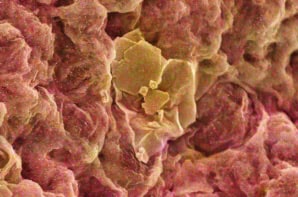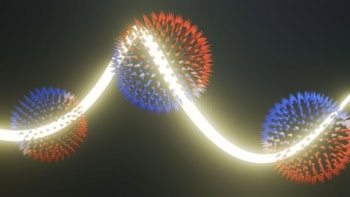
A single hydrogen molecule has been used to “push” an object much more massive than itself. So say researchers in Germany and Spain who have used a phenomenon called stochastic resonance to extract useful energy from “noise”. Their experiments involve using an atomic force microscope tip mounted on a flexible, spring-like cantilever and the processes at play might be exploited to power up nanometre-sized machines – or even much larger devices.
Stochastic – or random – resonance is well known in a range of complex systems, especially in living organisms, and is responsible for processes such as energy pumping. It allows weak periodic signals to be strengthened by surrounding noisy signals that arise from random fluctuations in the system. These ubiquitous fluctuations can come from temperature changes or from the movement of electrons and photons. The resonance occurs when random peaks in the noisy signal coincide with regular peaks in the periodic signal.
Scientists would like to mimic this ability that nature has of harvesting energy from random noise. Now, Jose Ignacio Pascual and colleagues at the Freie Universität Berlin and CIC nanoGUNE in San Sebastian have made some headway towards this goal by showing that the stochastic motion of vibrating hydrogen molecules can be used to move a mechanical cantilever.
Random switching
The researchers use the sensor of an atomic force microscope – a tip mounted onto a flexible, spring-like cantilever made of quartz. They then trap a single hydrogen molecule between the tip and a copper surface. A small voltage (of around 0.1 V) applied between the tip and the copper causes the hydrogen atom to switch randomly between two positional states and the cantilever begins to oscillate.
“We believe that the cantilever moves thanks to stochastic resonance, which uses the concerted motion of random hydrogen fluctuations and the well defined periodic motion of the mechanical oscillator, to amplify energy transfer from the molecule to the oscillator,” says Pascual. “The random motion of the hydrogen molecule effectively exerts nanoscale forces against the microscope tip, thus making it oscillate.”
In these experiments, the hydrogen molecule is made to move by applying a voltage through the molecule, continues Pascual. “There is nothing to say, however, that the effect could not occur for molecular fluctuations induced by other sources of energy, like light, for example.”
Rotation from noise
According to the team, the processes observed could be exploited to help design artificial molecular motors. “Energy from noisy environments could be extracted to drive the rotation of the motor, for instance,” says team member Felix van Oppen, who was responsible for developing theoretical models to help interpret the experimental results.
“Our work shows that the smallest possible molecule, hydrogen, is capable of ‘pushing’ an oscillator 1019 times bigger than itself,” adds Pascual, “This is a result that will spur us on to search for other sources of molecular noise, like electrical or magnetic fluctuations, which might even lead to more efficient energy transfer to a mechanical oscillator,” he says.



